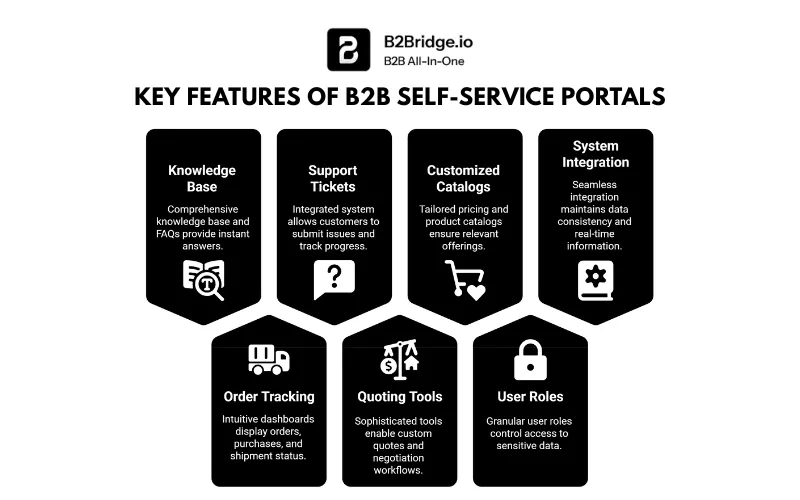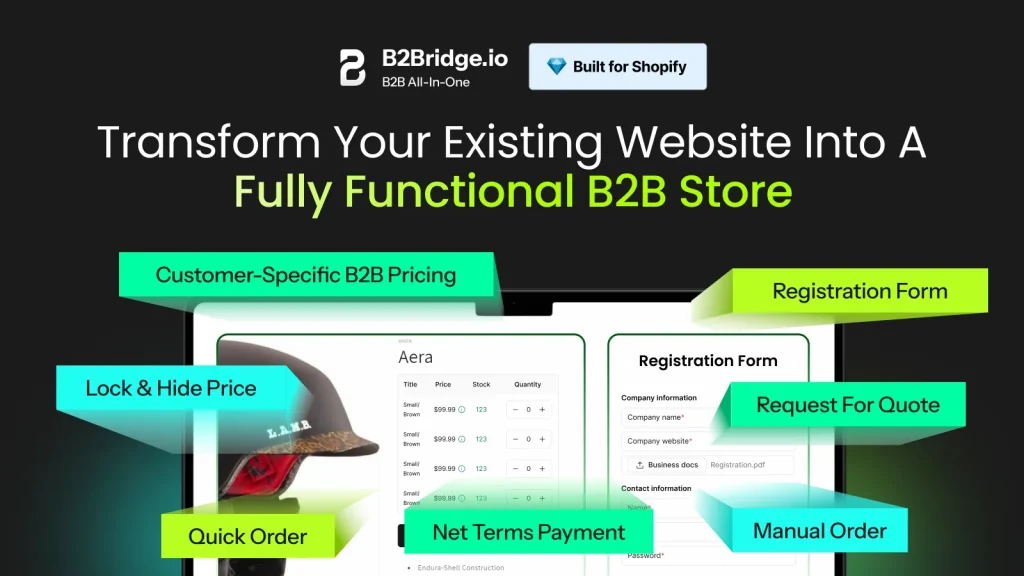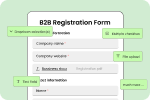A B2B self-service portal is a centralized, secure digital platform that empowers business customers to independently manage their orders, payments, support requests, and product information without waiting for sales representatives or support teams.
By providing 24/7 access to critical business functions, B2B self-service portals enhance customer experience while dramatically improving operational efficiency. Whether you’re a manufacturer, distributor, or technology supplier, implementing a robust self-service portal can be the difference between meeting customer expectations and falling behind competitors who offer more convenient, scalable digital experiences.
This comprehensive guide covers everything you need to know about B2B self-service portals:
- What is a B2B self-service portal?
- Five key benefits of B2B self-service portals
- Essential features of B2B self-service portals
- Real-world case studies of B2B service portals
- Best practices for implementation
- How to become the best B2B self-service portal on Shopify
- Future trends of B2B self-service portals
- Answers to common questions about B2B self-service portals

What Is a B2B Self-Service Portal?
A B2B self-service portal is a dedicated web-based platform that enables business customers to access account information, place orders, manage payments, and resolve issues independently. Unlike consumer-facing portals, B2B self-service portals are designed specifically for the complexity of business-to-business transactions, featuring secure login systems, personalized dashboards tailored to each customer’s unique relationship with your company, and real-time access to account data that reflects negotiated pricing, credit terms, and purchasing history.

The power of a modern B2B self-service portal lies in its integration capabilities. These platforms seamlessly connect with your existing Enterprise Resource Planning (ERP), Customer Relationship Management (CRM), and inventory management systems to provide up-to-date product availability, dynamic pricing based on customer agreements, and real-time order information. This integration ensures that customers always see accurate data, eliminating the frustration of outdated catalogs or pricing discrepancies that require lengthy back-and-forth communications.
Core functionalities of a comprehensive B2B self-service portal include intuitive order placement with reorder capabilities based on purchase history, complete invoice viewing and payment processing, streamlined quote request workflows that accelerate the sales cycle, efficient return management with automated RMA processes, and integrated support ticketing systems that track issues from submission to resolution. These features work together to create a unified experience where customers can handle virtually any transaction or inquiry without picking up the phone or sending an email.
Benefits of B2B Self-Service Portals
1. Enhance Customer Experience and Satisfaction
The modern B2B buyer has evolved dramatically in recent years. Research shows that 89% of B2B customers spend more when self-service options are available, demonstrating the direct correlation between customer empowerment and business growth. When customers can access their accounts, check order status, download invoices, and resolve simple issues on their own schedule, they feel more in control of their business relationships.
This increased control translates directly into customer satisfaction and loyalty. Customers no longer need to wait for business hours to check a shipment status or review their payment history. They can access critical information at midnight before an important meeting or during a weekend when planning next week’s operations. This convenience builds trust and strengthens relationships, leading to higher retention rates and increased lifetime customer value. The ability to quickly reorder products based on past purchases or access customized catalogs streamlined specifically for their needs creates a friction-free experience that keeps customers coming back.
2. Reduce Operational Costs and Support Load
Implementing a B2B self-service portal delivers measurable cost savings across multiple areas of your business:
- Dramatically lower call and email volume to customer service teams, with many companies reporting 50-70% reductions in routine inquiries about order status, invoice copies, and product availability
- Automated FAQ systems and searchable knowledge bases deflect repetitive questions that previously consumed valuable support time, allowing teams to focus on complex, high-value customer issues
- Peer-to-peer community forums enable customers to help each other, creating a self-sustaining support ecosystem that reduces demand on your internal resources
- Reduced order processing costs through direct customer entry, eliminating manual data entry errors and the time required for sales reps to process routine reorders
- Lower training costs for customer service staff, as the portal handles standard transactions and inquiries automatically
3. Provide 24/7 Access Across Devices
Global business operates around the clock, but your support team doesn’t. A B2B self-service portal bridges this gap by providing uninterrupted access to essential business functions regardless of time zones or staffing limitations. Customers in Asia can place orders while your North American office sleeps. European partners can resolve billing questions before your team arrives in the morning. This continuous availability isn’t just convenient – it’s a competitive necessity in international markets.
Modern portals are fully responsive, delivering seamless experiences across desktop computers, tablets, and smartphones. Whether a purchasing manager is reviewing orders from their office workstation or a warehouse supervisor is checking inventory availability from their mobile device on the floor, the portal adapts to provide optimal functionality. This device flexibility ensures that your customers can do business with you whenever and wherever they need to, removing barriers that might otherwise send them to competitors with more accessible systems.

4. Increase Order Accuracy and Speed
Manual order processing creates numerous opportunities for errors – misheard phone numbers, transcription mistakes, unclear handwriting on fax orders, or misinterpreted email requests. B2B self-service portals eliminate these risks by allowing customers to directly manage their orders through intuitive interfaces that validate data in real-time. When customers can see product specifications, verify pricing, and confirm delivery addresses before submitting orders, error rates plummet.
The speed improvements are equally significant. Traditional ordering processes might involve multiple phone calls, email exchanges, and manual approvals that stretch over hours or even days. With a self-service portal, customers can complete complex orders in minutes, using features like quick reorder from purchase history, bulk upload via CSV files for large orders, and saved shopping lists for frequently ordered items. This acceleration of the purchase cycle means faster revenue recognition for you and quicker delivery for customers – a win-win that strengthens business relationships and improves cash flow.
5. Improve Data Quality and Transparency
Data accuracy is fundamental to successful B2B relationships. When your self-service portal integrates directly with your ERP, CRM, and inventory management systems, customers always see real-time information about pricing, product availability, and order status. This transparency eliminates the “black box” frustration where customers wonder whether their order was received, when it will ship, or if the pricing they were quoted is still valid.
Real-time data synchronization ensures that inventory levels reflect actual warehouse stock, pricing updates appear immediately across all customer accounts, and order status changes trigger automatic notifications. Customers receive instant updates when orders ship, tracking numbers when available, and alerts if there are any delays or issues. This proactive communication builds confidence and reduces anxiety, particularly for time-sensitive orders. The result is a more trusting relationship where customers feel informed and valued rather than left in the dark about critical business transactions.
Key Features of B2B Self-Service Portals

Essential features that distinguish effective B2B self-service portals include:
- Comprehensive knowledge base and FAQs that provide instant answers to common questions about products, ordering processes, shipping policies, and troubleshooting, reducing dependence on support staff
- Intuitive order tracking and management dashboards that display current orders, historical purchases, shipment status, and delivery confirmations in a single, easy-to-navigate interface
- Integrated support ticketing systems that allow customers to submit issues, attach relevant documentation, track resolution progress, and communicate with support teams without leaving the portal
- Sophisticated quoting tools and negotiation workflows that enable customers to request custom quotes, review proposals, negotiate terms, and convert quotes to orders seamlessly
- Customized pricing and product catalogs tailored to each customer’s negotiated rates, approved product lists, and purchasing agreements, ensuring they always see relevant offerings at correct prices
- Granular user roles and permissions that allow businesses to control which employees can place orders, approve purchases, view financial information, or access sensitive data
- Seamless integration with CRM, ERP, and inventory systems that maintains data consistency, eliminates duplicate entry, and provides real-time information flow between customer-facing and backend systems
Ready to transform your B2B customer experience? B2Bridge specializes in building custom self-service portals that integrate seamlessly with your existing systems. Discover how we can help.
Real-World Examples of B2B Self-Service Portals
Case Study 1: Wholesale Distribution Platform
A major wholesale distributor serving over 5,000 retail businesses implemented a comprehensive B2B self-service portal to address growing support demands and customer frustrations with order processing delays. The portal provided customers with real-time inventory visibility, automated reordering based on sales velocity, and integrated order tracking from warehouse to delivery.
The results exceeded expectations. Support inquiries dropped by 60% within the first six months as customers found answers through the knowledge base and tracked orders independently. Repeat purchase rates increased by 34% thanks to simplified reordering features that remembered customer preferences and suggested complementary products. Perhaps most impressively, order processing time decreased from an average of 48 hours to just 6 hours, dramatically improving customer satisfaction scores and enabling faster delivery cycles.
Case Study 2: Manufacturing Supplier Portal
An industrial manufacturing company serving enterprise clients struggled with accounts receivable challenges stemming from invoice disputes and unclear payment terms. They launched a self-service portal that provided complete transparency into invoicing, payment history, and contract terms, with downloadable documentation and automated payment reminders.
The portal transformed their financial operations by improving invoice transparency and payment reconciliation. Customers could instantly access current and historical invoices, view applied payments, and resolve discrepancies without multiple email exchanges or phone calls. This clarity shortened the accounts receivable cycle by 25%, improving cash flow and reducing the administrative burden on the finance team. Customer relationships strengthened as billing disputes decreased and payment processes became more predictable and transparent.

Case Study 3: Technology Products Supplier
A B2B technology distributor implemented a sophisticated self-service portal featuring AI-powered product recommendations, personalized catalogs based on customer industry and purchase history, and dynamic quoting tools that allowed customers to configure complex technology solutions independently.
The personalization capabilities significantly increased customer engagement, with average session times increasing by 145% as customers explored relevant products and built custom configurations. The quoting features enabled customers to price complex solutions without waiting for sales representatives, accelerating the sales cycle by 40%. Most notably, average order values increased by 28% as the recommendation engine successfully introduced customers to complementary products and higher-tier solutions that matched their needs.
Best Practices for Implementing B2B Self-Service Portals
Successful B2B self-service portal implementation requires careful planning and execution:
- Conduct comprehensive customer needs analysis through surveys, interviews, and usage data analysis to understand which features will deliver the most value and ensure high adoption rates
- Design intuitive, mobile-responsive interfaces that prioritize user experience with clear navigation, logical information architecture, and consistent design patterns that minimize the learning curve
- Ensure tight integration with backend systems including ERP, CRM, and inventory management platforms to maintain data accuracy and provide real-time information that customers can trust
- Develop rich, searchable content for your knowledge base with regular updates, clear categorization, and multimedia support including videos, diagrams, and step-by-step tutorials
- Implement AI-powered chatbots that provide immediate assistance for common questions while intelligently routing complex issues to human support teams when necessary
- Create comprehensive onboarding and training programs with video tutorials, guided tours, and dedicated support during the initial rollout to encourage adoption and build user confidence
- Continuously monitor portal analytics to identify usage patterns, pinpoint friction points, track feature adoption, and gather insights that drive ongoing optimization and enhancement
Looking to implement a best-in-class B2B self-service portal? B2Bridge’s expert team guides you through every step, from needs analysis to launch and beyond. Let’s talk about your portal project.
Become the Best B2B Self-Service Portal on Shopify with B2Bridge

Ready to implement a B2B self-service portal that delights customers and streamlines operations? B2Bridge specializes in building custom portal solutions that integrate seamlessly with your existing website.
Our expert team combines deep B2B commerce understanding with technical excellence to create portals that your customers will love and your operations team will appreciate. From initial strategy and design through implementation and ongoing optimization, we’re your partner in digital transformation.
Contact B2Bridge today to schedule a consultation and discover how a custom B2B self-service portal can transform your business relationships and accelerate growth.
Future Trends in B2B Self-Service Portals
The evolution of B2B self-service portals continues to accelerate as new technologies mature and customer expectations rise. AI-powered chatbots are becoming increasingly sophisticated, moving beyond simple FAQ responses to deliver personalized, context-aware support that understands customer history, anticipates needs, and proactively suggests solutions. These intelligent assistants can handle complex inquiries, guide customers through multi-step processes, and seamlessly escalate to human support when necessary.
Advanced analytics and machine learning are driving more dynamic, personalized portal experiences. Portals now use predictive algorithms to forecast customer needs based on purchase patterns, seasonal trends, and industry cycles, proactively suggesting reorder timing and quantities. Dynamic content personalization adjusts portal layouts, featured products, and promotional content based on individual customer behavior and preferences, creating unique experiences that maximize relevance and engagement.
Voice command integration and mobile-first design are reshaping how customers interact with B2B portals. Voice-activated ordering, status checks, and navigation make portals more accessible, particularly for users in warehouse or field environments where hands-free operation provides significant advantages. Mobile-first design philosophy ensures that portals aren’t just responsive but are optimized specifically for smartphone and tablet usage, recognizing that mobile devices are often the primary access point for busy professionals.
Increased automation continues to expand portal capabilities, with intelligent systems handling complex workflows like multi-tier quote approvals, automated return authorizations based on predefined criteria, and dynamic pricing adjustments based on inventory levels and demand forecasting. These automations don’t just improve efficiency – they create more responsive, flexible business relationships that adapt to changing circumstances in real-time.
FAQs about B2B Self-Service Portals
Most businesses see positive ROI within 12-18 months through reduced support costs, increased order efficiency, and improved customer retention. Studies show average cost savings of 30-50% in customer service operations, while revenue impacts include 15-25% increases in repeat purchase frequency and 10-20% growth in average order values due to improved customer experience and self-service upselling capabilities.
Modern B2B self-service portals use API connections, middleware platforms, or direct database integration to synchronize with existing business systems. Real-time or near-real-time data exchange ensures customers always see accurate inventory, pricing, and order information. Most enterprise portals support standard integration protocols and can connect with popular platforms like SAP, Oracle, Microsoft Dynamics, Salesforce, and HubSpot, though custom integrations may be necessary for proprietary systems.
Priority content includes product specifications and compatibility information, ordering and shipping policies, return and warranty procedures, troubleshooting guides and technical documentation, billing and payment explanations, and account management instructions. Effective knowledge bases organize content by user role and common tasks, use clear language without unnecessary jargon, include visual aids and videos where helpful, and are regularly updated based on actual support inquiries and user feedback.
A B2B portal is an online platform where companies buy and sell directly with other businesses. Buyers typically use it to source office supplies, acquire equipment and materials for production, or purchase inventory to resell in their own stores or channels.
Conclusion
B2B self-service portals have evolved from nice-to-have features to essential competitive advantages in modern business commerce. By empowering customers with 24/7 access to accounts, orders, support resources, and critical business information, these platforms simultaneously enhance customer satisfaction and dramatically improve operational efficiency.
The benefits are clear and measurable: reduced support costs, increased order accuracy, faster purchase cycles, and stronger customer relationships built on transparency and convenience. As technology continues advancing, B2B self-service portals will become even more intelligent, personalized, and integral to successful business relationships.
Whether you’re looking to reduce support burden, scale operations without proportionally increasing staff, or meet rising customer expectations for digital convenience, a well-implemented B2B self-service portal delivers results that impact your bottom line and position your business for sustainable growth.
Hi, I’m Ha My Phan – an ever-curious digital marketer crafting growth strategies for Shopify apps since 2018. I blend language, logic, and user insight to make things convert. Strategy is my second nature. Learning is my habit. And building things that actually work for people? That’s my favorite kind of win.







